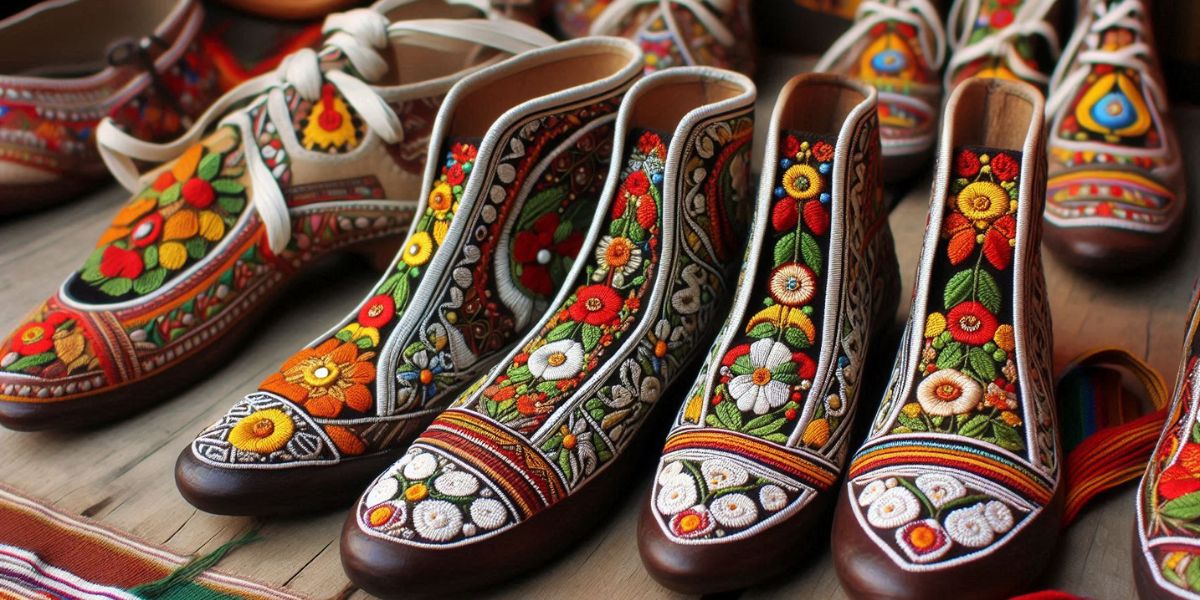Footwear is more than just a necessity—it reflects a culture, history, and identity. Across the world, different regions have developed unique footwear traditions that combine practicality, style, and craftsmanship. These traditional shoes often tell stories of the climate, lifestyle, and creativity of the people who make and wear them. In this blog, we’ll explore the fascinating features of regional footwear traditions, highlighting their cultural significance and timeless charm.
Why Footwear Traditions Are Special
Footwear traditions hold a special place in culture because they reflect different regions’ unique lifestyles and environments. For example, sturdy wooden clogs in northern Europe were created to handle muddy farmlands, offering durability and practicality. In contrast, lightweight leather sandals in the Mediterranean were designed to keep feet cool in the region’s warm climate. These traditional designs go beyond functionality—they showcase how people adapted to their surroundings while expressing their identity through craftsmanship and creativity. Each style carries a story, blending culture, history, and ingenuity, making footwear traditions a meaningful part of the heritage they represent.
Iconic Footwear Styles Around the World
Mojaris from India
Mojaris are traditional Indian shoes known for their intricate embroidery and vibrant colours. Often made from leather and decorated with threads, beads, and sequins, they are ideal for festive occasions. These shoes are designed without a left or right distinction, making them versatile and comfortable.
Geta and Zori from Japan
In Japan, geta and zori are traditional sandals that combine style and functionality. Geta are wooden platform sandals often worn with kimonos, while zori are flat sandals made with straw or cloth. These shoes are not just footwear but symbols of Japanese aesthetics and practicality.
Espadrilles from Spain
Espadrilles are casual summer shoes originating from Spain. They are lightweight and breathable, made with a canvas or cotton upper and a rope sole, perfect for warm climates.
Espadrilles have become globally famous for their simple yet chic look.
Bast Shoes from Russia
Bast shoes, or “lapti,” are woven from the bark of trees like linden or birch. Russian peasants commonly wore these lightweight shoes for centuries. Though rarely used today, bast shoes symbolise traditional Russian craftsmanship.
Materials and Craftsmanship
Regional footwear stands apart because of its emphasis on local materials and skilled craftsmanship. In many cultures, these shoes are handmade, ensuring attention to detail and quality. From leather tanning in Morocco to weaving in Mexico, each pair is often a piece of art.
For example, the Friulane Shoes, traditionally made in the Friuli region of Italy, are a prime example of this craftsmanship. Friulane Shoes are known for their velvet finish, hand-stitched construction, and rubber soles from recycled bicycle tyres. Venetian gondoliers originally wore these shoes, and they have become a sustainable and stylish choice for modern fashion.
How Climate Shapes Footwear?
Climate plays a significant role in influencing footwear design. In colder regions like Scandinavia, fur-lined boots and clogs are common, providing insulation against harsh winters. Conversely, in desert regions like North Africa, leather sandals with open designs keep feet cool while protecting them from sand. Traditional shoes also adapt to seasonal changes. For example, the straw slippers of Korea, called “jipsin,” are perfect for hot summers, while heavier boots are preferred in winter.
The Cultural Significance of Footwear
Footwear is often more than practical—it can carry deep cultural meaning.
- Ceremonial Importance: In many cultures, specific types of shoes are reserved for special occasions like weddings or festivals. For instance, in Pakistan and India, brides wear heavily embellished juttis that match their wedding attire.
- Symbol of Status: Historically, footwear has been used to indicate social status. The more elaborate the design and the rarer the material, the higher the wearer’s status. This was evident in ancient Egypt, where the colour and material of sandals often denoted rank.
- Connection to Heritage: Traditional footwear helps people stay connected to their roots, especially in an increasingly globalised world.
Revival of Traditional Footwear in Modern Times
In recent years, traditional footwear has been appreciated more than ever as people seek sustainable, artisanal, and culturally rich products. Many brands and designers are reviving these styles, blending traditional techniques with modern aesthetics. For example, traditional clogs have come back in high fashion, and espadrilles are now a summer staple worldwide. Similarly, handcrafted shoes from different cultures are celebrated for uniqueness and sustainability.
Why Support Traditional Footwear?
Choosing traditional footwear supports artisans who rely on these crafts for their livelihood. These shoes often have a lower environmental impact than mass-produced alternatives. Handmade shoes are also more durable, making them a practical and eco-friendly choice.
Conclusion
The world of footwear is as diverse as the cultures that create it. Each style tells a unique story, from the colourful mojaris of India to the elegant Friulane Shoes of Italy. Exploring regional footwear traditions enriches our understanding of global cultures and reminds us of the artistry and effort that go into making these timeless pieces.
Traditional footwear is the perfect choice for adding a touch of heritage and craftsmanship to your wardrobe. At Azaleri, we celebrate these timeless designs by offering a curated shoe collection that reflects global traditions. Step into a world of style, culture, and sustainability with Azaleri.
